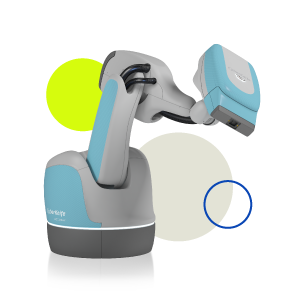This year’s ESTRO theme ‘From innovation to action’ really exemplifies the process of taking new ideas, technologies, or techniques and implementing them into clinical practice to improve patient outcomes. The importance of research to provide strong evidence to support these changes is crucial to ensure implementation is safe and effective.
The use of stereotactic body radiotherapy (SBRT) and stereotactic radiosurgery (SRS) has increased for certain patient groups. In this year’s submitted research from ESTRO we are seeing the advantages of SBRT and SRS in more indications. The high precision of the CyberKnife® and Radixact® Treatment Delivery Systems with the added benefit of Synchrony® technology that enables real-time target tracking gives healthcare professionals and their patients the confidence for more accurate ITV free and gating free treatments. And we are pleased to see how this is being utilized in clinical practice to benefit patients.
Evidence-based benefits of the CyberKnife System
The CyberKnife Systems unique robotic technology enables the treatment of tumors in the head and throughout the body with extreme accuracy over a minimum number of treatment sessions. Our top pick of studies presented at ESTRO demonstrate:
How the CyberKnife System can benefit prostate cancer patients
We have seen an abundant number of abstracts this year to support the use of SBRT in prostate cancer patients from low-intermediate disease to high-risk disease. In a phase II study of low-risk disease authors concluded, “SBRT is a focused therapy that is feasible, well-tolerated, and preserves quality of life. This innovative robotized approach challenges other focused treatment alternatives as well as active surveillance” [1]. These studies build on published literature from the multicentric prospective phase II PACE-B trial demonstrating SBRT with the CyberKnife System can help minimize toxicity compared to linac-based techniques [2].
SRS demonstrated as ‘safe and effective’ for patients with uveal melanoma
This year’s abstracts included a vast number of intracranial indications including brain metastases and primary tumors as well as re-irradiation techniques. As it is Melanoma Cancer Awareness Month, we highlight an abstract on a large cohort of 594 patients treated with the CyberKnife System for uveal melanoma. This abstract concluded that SRS is a ‘safe and effective treatment’ for uveal melanoma, achieving eye retention and local control in the majority of patients [3].
Expanding treatment options for patients with advanced and inoperable pancreatic cancer
Pancreatic cancer is often diagnosed at an advanced stage. For patients where the tumor has spread to nearby lymph nodes or to another part of their body the prognosis is often dismal [4]. Only around 10% of people can have surgery to remove pancreatic cancer [5]. This that are inoperable typically have a short overall survival of less than 6 months. Knowing this makes it even more important to expand treatment options for this category of patients. SBRT is being used with increasing frequency and has shown favorable clinical results. For one study SBRT was delivered with the CyberKnife System in inoperable pancreatic cancer patients using real-time motion tracking image-guided radiation therapy. It demonstrated a promising median overall survival of 9.6 months with 50% of patients reporting mild toxicity of grade 1 and grade 2 fatigue within 12 months post SBRT [6]. A shortened treatment regime with low toxicity is of the upmost importance for these patients to increase their quality of life.
Evidence-based benefits of the Radixact System
The TomoTherapy® platform broke new ground with the development of the first CT-linac using helical radiation delivery and integrated imaging, enabling precise and efficient radiation dose delivery for a wide range of patients, including those with complex indications. Our top pick of studies presented at ESTRO demonstrate:
Helical TomoTherapy offers optimal plans for implant-based breast radiation therapy
Immediate breast reconstruction (IBR) after mastectomy is increasing. The reconstructed breast volume can provide challenges when treating with radiotherapy making it difficult to help ensure optimal coverage while minimizing dose to organs at risk (OARs). More centers are taking advantage of helical delivery with the TomoTherapy System. One study demonstrated how helical TomoTherapy provides optimal plans in terms of the planning target volume (PTV) coverage and OAR sparing in a challenging population of postmastectomy patients with IBR [7]. Another study reported its experience with implant-sparing radiotherapy in patients’ with IBR called the HALFMOON technique (Helical Altered Fractionation for iMplant partial OmissiON). Out of 47 patients they conclude that the HALFMOON technique was feasible with acceptable capsular contracture [8]. This helps patients to have a better cosmetic outcome post radiotherapy.
Total marrow irradiation with helical TomoTherapy achieves good results
More studies are demonstrating the replacement of total body irradiation with total marrow irradiation especially in patients that have suffered a relapse after initial treatment. A prospective, phase 1 study used TomoHelical™ in combination with melphalan and autologous transplant producing good results with acceptable toxicity in patients with relapsed multiple myeloma at 55 months follow-up [9]. Another study utilized surface-guided helical TomoTherapy for TMI to improve patient positioning allowing margins to be further reduced decreasing dose to OARs while maintaining target coverage [10].
Real-time target tracking reduces treatment margins in lung cancer
Several studies at ESTRO 2023 have shown that real-time tracking with Synchrony on the Radixact System allows a reduction of the planning target volume by 20.8% in patients with inoperable NSCLC and lung oligometastases compared to linac-based techniques without tumor tracking. In both studies the Radixact System with Synchrony’s real-time tracking technology demonstrated that the median beam on time was less than 10 minutes with no discomfort even in fragile patients [11,12]. This helps to demonstrate the feasibility of delivering real-time motion tracking in a suitable treatment time for radiotherapy clinics.
From innovation to action...
References
- P Nguyen et al., ‘Stereotactic focused radiotherapy for low-risk prostate cancer: results of a Phase-II trial’ ESTRO 2023.
- A Tree et al., ‘Intensity-modulated radiotherapy versus stereotactic body radiotherapy for prostate cancer (PACE-B): 2-year toxicity results from an open-label, randomised, phase 3, non-inferiority trial’. Lancet Oncol. 2022 Oct;23(10):1308-1320.
- F Ehret et al., ‘Stereotactic radiosurgery in the management of uveal melanoma – treatment results of 594 patients’ ESTRO 2023.
- C Cabasag et al., ‘Pancreatic cancer survival by stage and age in seven high-income countries (ICBP SURVMARK-2): a population-based study’ British Journal of Cancer, March 2022. V:126, P:1774-1782
- https://www.cancerresearchuk.org/about-cancer/pancreatic-cancer/survival
- J Duong et al., ‘Clinical outcomes following stereotactic ablative body radiotherapy to inoperable pancreatic cancer’ ESTRO 2023.
- Dicuonzo et al., ‘Plan quality comparison at 5 years in 2 cohorts of breast cancer patients treated with Tomotherapy®’ ESTRO 2023
- M Zaffaroni et al., ‘Halfmoon radiotherapy: a real-world experience in a single institution’ ESTRO 2023
- A Cailleteau et al., ‘Phase 1 study of escalated total marrow irradiation and melphalan at 1st relapse in multiple myeloma’ ESTRO 2023.
- H Enocson et al., ‘Surface Guided Helical Tomotherapy for Total Marrow Irradiation’ ESTRO 2023
- M Cerrato et al., ‘Dosimetric and clinical aspects of lung SABR delivered with Synchrony® tracking on TomoTherapy’ ESTRO 2023
- F Menegatti et al., ‘Initial clinical experience with ITV-free Lung SABR using Synchrony tracking on Radixact TomoTherapy’ ESTRO 2023









